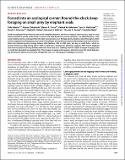Forced into an ecological corner : round-the-clock deep foraging on small prey by elephant seals
Abstract
Small mesopelagic fishes dominate the world’s total fish biomass, yet their ecological importance as prey for large marine animals is poorly understood. To reveal the little-known ecosystem dynamics, we identified prey, measured feeding events, and quantified the daily energy balance of 48 deep-diving elephant seals throughout their oceanic migrations by leveraging innovative technologies: animal-borne smart accelerometers and video cameras. Seals only attained positive energy balance after feeding 1000 to 2000 times per day on small fishes, which required continuous deep diving (80 to 100% of each day). Interspecies allometry suggests that female elephant seals have exceptional diving abilities relative to their body size, enabling them to exploit a unique foraging niche on small but abundant mesopelagic fish. This unique foraging niche requires extreme round-the-clock deep diving, limiting the behavioral plasticity of elephant seals to a changing mesopelagic ecosystem.
Citation
Adachi , T , Takahashi , A , Costa , D P , Robinson , P W , Hückstädt , L A , Peterson , S H , Holser , R R , Beltran , R S , Keates , T R & Naito , Y 2021 , ' Forced into an ecological corner : round-the-clock deep foraging on small prey by elephant seals ' , Science Advances , vol. 7 , no. 20 , eabg3628 . https://doi.org/10.1126/sciadv.abg3628
Publication
Science Advances
Status
Peer reviewed
ISSN
2375-2548Type
Journal article
Description
This study was supported by grants from Grant-in-Aid for Scientific Research from the Japan Society for the Promotion of Science (23255001, 15K14793, and 20H00650), Grant-in-Aid for JSPS Fellows (12J04316 and 16J02935), Grant-in-Aid for Research Activity Start-up (15H06824), the Office of Naval Research grants N00014-10-1-0356 and N00014-13-1-0134, and the E&P Sound and Marine Life Joint Industry Project of the International Association of Oil and Gas Producers.Collections
Items in the St Andrews Research Repository are protected by copyright, with all rights reserved, unless otherwise indicated.

